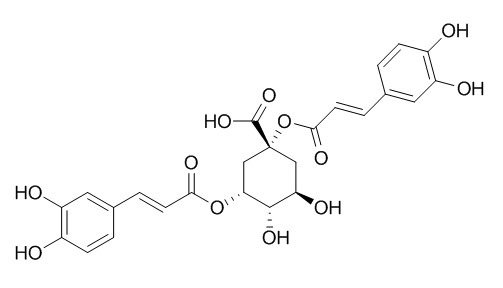Natural Products
1,3-Dicaffeoylquinic acid
| Catalog No. | CFN99123 |  |
| CAS No. | 30964-13-7 | |
| Molecular Weight: | 516.45 | |
| Molecular Formula | C25H24O12 | |
| DBs | [PubChem]:274951295 [ChEMBL]: [PCIDB]:2733 |
Standard InChI:
InChI=1S/C25H24O12/c26-15-5-1-13(9-17(15)28)3-7-21(31)36-20-12-25(24(34)35,11-19(30)23(20)33)37-22(32)8-4-14-2-6-16(27)18(29)10-14/h1-10,19-20,23,26-30,33H,11-12H2,(H,34,35)/b7-3+,8-4+/t19-,20-,23+,25-/m1/s1
Biological Activity
1,5-Dicaffeoylquinic acid (1,5-DQA), a caffeoylquinic acid derivative isolated from Aster scaber, has neuroprotective effects, can prevent Aβ(42)-induced neurotoxicity through the activation of PI3K/Akt followed by the stimulation of Trk A, then the inhibition of GSK3β as well as the modulation of Bcl-2/Bax.[1]
1,5-Dicaffeoylquinic acid has antioxidant activity, and is stronger than that of ascorbic acid.[2]
1,5-Dicaffeoylquinic Acid has protective effects against MPP~+ induces neurotoxicity of PC12 Cells, it (50 μmol/L) pretreatment can inhibit the MPP+-induced up-regulation of the expression of α-synuclein mRNA and protein.[3]
1, 5-Dicaffeoylquinic acid can mediate glutathione synthesis through activation of Nrf2 protects against OGD/reperfusion-induced oxidative stress in astrocytes.[4]
Product
Official website: 1,3-Dicaffeoylquinic acid
Japanese website: 1,3-Dicaffeoylquinic acid
Chinese website: 1,3-Dicaffeoylquinic acid
Japanese website: 1,3-Dicaffeoylquinic acid
Chinese website: 1,3-Dicaffeoylquinic acid
References
[1] XIAO, Hai-bing, WANG, et al. Chinese Medl Jl, 2011, 124(17):2628-35.
[2] Slanina J, Paulová H, Humpa O, et al. Organic Chem, 1999, 72.
[3] Cao X, Xiao H, Li H. Acta Med Universit Sci Et Technol Huazhong, 2010, 39(4):435-38.
[4] Xu C, Xiao H, Zhang Y, et al. Brain Res, 2010, 1347(1):142-8.
[5] Dong Y, Zhang Y, Liu Y, et al. Chinese J Pharm, 2010, 41(6):447-9.
Product Use Citation





